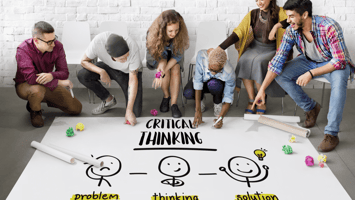Online Course Development A-Team? Once upon a time, developing educational content was a somewhat...
Boost team performance by 10x with these 3 soft skills (every manager should teach today)
What are the soft skills to teach for a high performing team? Another question for you... Do you think school actually taught us how to work well as part of a high performing team? We probably had teachers helpfully teach us to assign roles or sign ‘contracts’ to promise we’ll play nice. And, since it’s school, we needed to rate everybody once we’d completed the work.

But are those the soft skills needed for a high performing team?
Yes, those skills are great for a work group—one where you share ideas and help each other out occasionally, but you usually complete tasks individually. But if you’re working in an interdependent team—one where each member needs other to complete tasks—then those skills won’t make the grade.
Today’s problem? Many of us work in highly interdependent teams.
The Foundation for Young Australians found that Australian job ads request teamwork as a key skill 19% more than in the past. It’s obvious we need to focus on teamwork to prepare young people for the jobs of tomorrow.
But what specific soft skills do people need to make a high performing team productive, efficient, and most importantly, goal achieving?
Characteristics of a high performing team
When Google researched effectiveness inside its internal teams, they discovered 5 key characteristics of a high performing team:
- Psychological safety
- Dependability
- Structure and clarity
- Meaning
- Impact
These interesting findings show a relationship between the individuals on the high performing team, the team itself, and the organization as a whole. To become high performing, everyone has a role to play in fostering innovative teamwork.
In this post, we’ll focus on how learning designers can teach 3 key soft skills to companies to help employees create an environment of psychological safety, increased dependability, and clear structure and clarity.

Active listening
The first domain is called ‘psychological safety’. Amy Edmondson, an organizational behavioral scientist at Harvard, defines psychological safety as:
“A belief that one will not be punished or humiliated for speaking up with ideas, concerns, questions or mistakes.”
Honestly, managers, executives and co-workers pay a huge role in creating a psychologically safe work environment for a high performing team. You can’t decide if your manager asks for input or encourages questions.
There is one soft skill everyone can practice no matter their role to help foster psychological safety. It’s known as Active Listening.
Here are a few tips from Google on how to listen actively:
- Be present by putting any devices away.
- Make eye contact.
- Respond verbally to show you’re listening (even just an, “I get it” goes a long way to making people feel heard).
- Nod your head to show understanding.
- Ask questions based on what’s been said.
- Demonstrate listening by repeating and rephrasing what someone’s already said. You can add agreements or disagreements, too, but do so respectfully.
- Avoid putting anyone down personally or placing blame. Focus on moving toward solutions.
This means insisting on cameras on for webinars! After all, you wouldn’t come into a meeting with a bag over your head would you? Learning designers can also use video to show people putting the above tips into action.
You can also create scenarios for learners to critique—this way they’ll learn the characteristics of a psychologically safe workplace for a high performing team. Finally, reflection questions keep active listening at the top of the mind so people can bring this soft skill into their daily flow of work.
Amy Edmondson, a Novartis Professor of Leadership and Management at Harvard Business School suggests we acknowledge our own fallibility in her Building a psychologically safe workplace TED Talk. In a high performing team, let coworkers know that you might miss something, and then they’ll feel free to tell you their concerns.

Conscientiousness
Google called this domain ‘dependability’, or more accurately; getting your stuff done on time. Psychologists call these wonderful people conscientious.
Can we teach people how to be conscientious?
While it’s considered a personality trait, anyone can cultivate conscientious habits. Here are three suggestions from Harvard to help you design tasks to raise anyone’s conscientious quotient:
- Choose a measurable conscientious habit: Examples include organizing your desk, being punctual, meeting deadlines, saying thank you or complimenting your team members. Then create a checklist or system to help support people in this behavior change. Also, encourage learners to set a reminder or schedule a time to practice their new habit. Learning designers can also provide forums for people to network and support each other in changing their habits.
- Create a high performing team work schedule: You’ll be more likely to deliver work on time with a schedule. You can ensure quality work by building time to review it into your schedule. Working on schedules together also helps teams break a project down into its composite parts. Learning designers can create scenarios to help strengthen project management skills, and also explicitly teach backwards planning to help teams set reasonable goals for the end product.
- Set reminders: You may use a company-wide tool or suggest productivity apps to help people stick to their new conscientious habits.
Of course, there’s an organizational component. Companies need to outline roles and responsibilities for their employees, as well as deadlines. Also, a high performing team using project management tools probably has a leg up since conscientiousness revolves around organization and punctuality.

Goal setting
A high performing team operates in organizations with structure and clarity. It’s not just individuals goal setting, but whole teams.
But let’s back up and talk about how to write clear goals first.
Lots of people successfully use SMART (specific, measurable, achievable, realistic and timely). But it’s probably not enough.
People need help learning how to align their individual goals to business goals. Learning and Development can communicate business goals, while encouraging employees to find training corresponding to both add value to their company and meet their personal desires.
Learning and development can create microlearning content to suggest business-aligned goals that might interest people in different roles. They can also create scenarios where learners suggest ways that personal goals can be aligned with business results.
Learning designers can liaise with executives to create a questionnaire to help employees query whether their goals align with top business priorities, as well as whether they bring value to customers. Top executives want a motivated workforce and challenging goals help improve employee engagement.
Without psychological safety, people don’t want to try stretch goals. They’d prefer to stay in their comfort zone.
But innovation requires setting stretch goals. The misunderstanding of a stretch goal is that people often don’t achieve all of it. Companies need to be comfortable with teams only delivering some of the results in a stretch goal.
That’s why the psychological safety domain always comes first—people need to feel comfortable enough to fail to drive innovation.

In conclusion
A high performing team requires a complex hybrid of individual talents and corporate culture.
Fortunately, it can all be taught. Anyone can learn how to engender the appropriate characteristics of high performing teams by being a more supportive team member, engaging active listening skills and setting clear, measurable goals. It just starts with constructive learning design.
What ways do you use to teach soft skills? Contact us at hello@oppida.co to discuss your ideas.


